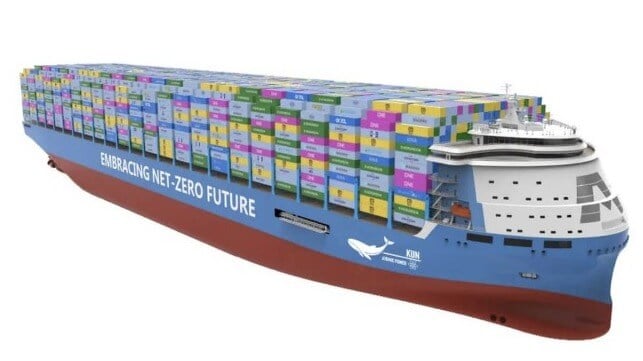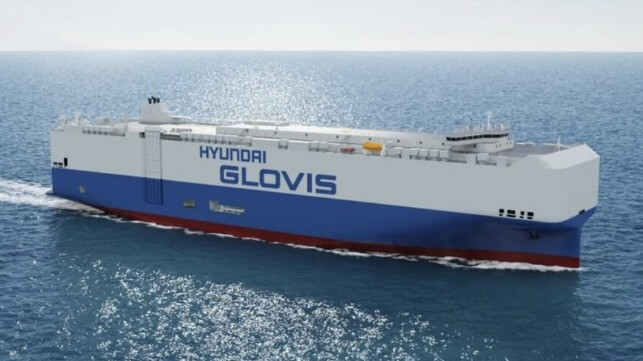CSSC Designs Containership Using Molten Salt Nuclear Reactor

Designs were unveiled in China today, December 5, for the world’s first large containership using the new nuclear power concept known as Molten Salt reactors. The design was developed by Jiangnan Shipbuilding, a division of the Chinese state-owned China State Shipbuilding Corporation (CSSC) and as if to prove that it is more than a theory, they reported that DNV issued an Approval in Principle (AiP) certificate for the design.
Few details were provided for the design with reports highlighting that China has classified the details of its efforts with thorium-based reactors because of the potential military applications. China however highlights that it has an abundant and less expensive supply of thorium meaning that it could be a cost-effective and zero-emission alternative for shipping and other industries. The thorium would be used as a safer alternative to uranium-based reactors.
CSSC writes in a statement posted to Weibo, “This type of ship has high safety as the reactor operates at high temperatures and low pressure, meaning it can avoid in principle core melting.” They highlight that the thorium reactor would not require high-pressure containers and pipelines as the reactor does not use large amounts of water for cooling. In the event of an accident, the core solidifies at ambient temperature, and in addition to normal shutdown methods, CSSC writes that the salt fuel can also be quickly discharged from the reactor to prevent spreading.
The concept design is for a 24,000 TEU containership, which they are calling the world’s largest nuclear-powered containership. Other safety features they reported include the location of the reactor, which was not explained. CSSC highlights that the concept adopts a “double-sided redundant design.”
Reporting on the presentation at a conference in China, the South China Morning Post says China got the first thorium-based molten salt reactor running earlier this year during a test in the Gobi Desert. The paper contends most countries including the United States have abandoned efforts to develop the reactors because of the complexity of the technology.
Several projects are looking at the concept of the Molten Salt reactor to provide mobile power but this appears to be the most advanced design. In the United States, the American Bureau of Shipping was contracted to lead a study into nuclear propulsion and its applications to commercial shipping nearly 80 years after the U.S. demonstrated the first commercial nuclear propulsion ship, the now long-ago retired ns Savannah. Russia continues to operate a nuclear-powered commercial ship while several projects are exploring Molten Salt reactors placed on barges or ships that could be positioned to provide power in remote areas or for emergency recovery operations.
Car Carrier Boom: CSSC Books Order for 12, DNV Approves Largest Design

The vehicle transport sector is continuing its rapid growth with a new generation of the world’s largest Pure Car and Truck Carrier (PCTC) set to emerge from the Chinese shipyards. China State Shipbuilding Corporation (CSSC) celebrated the largest order for the largest yet-built car carriers while at the same time, China Merchants rolled out the design for an even larger ship. This comes as the sector is capacity-constrained and now has as many as 100 new vessels on order.
During this week’s China International Maritime Exhibition CSSC signed a multitude of orders but the company was highlighting what it said was the largest single PCTC order in shipbuilding history. It is for a new class of the vessel which they also highlighted as the largest and most advanced in the sector.
The new ships will have a total of 14 car decks with five of them being lift or movable decks for a total capacity of 10,800 units. The vessels will have the capability to load ultra-high and ultra-heavy ro-ro cargo as well as a range of vehicle types. Special consideration is given to transporting hydrogen, compressed natural gas, liquified petroleum, and other new technologies for powering vehicles including electric vehicles, which they expect will drive the industry’s growth. The ships will also be able to transport dangerous cargo and refrigerated containers.
The design and range of capabilities will improve the vessel’s density and flexibility of cargo loading. CSSC highlights that while the vessel’s capacity will be 16 to 20 percent larger than the current biggest vessels with a 9,000-unit capacity, transport costs will be eight percent lower per unit.
The ships will also be environmentally sensitive. They are designed to operate on LNG while also being ready for either ammonia or methanol.
Two of CSSC’s subsidiaries booked a combined order for a minimum of 12 of the vessels and possibly as many as 20 if the options are exercised. As was announced earlier in the week, six of the vessels will be built at Shanghai Waigaoqiao Shipbuilding for Seaspan. It marks the first time the containership company has expanded into the car carrier segment. They also have an option for up to four more vessels.
In a second surprise development, South Korea’s HMM, another primarily container carrier, also ordered six of the vessels to be built at Guangzhou Shipyard. They also have an option for up to four more ships. It is part of HMM’s previously announced strategy designed to expand the company and diversify into other segments to balance with the performance of the containerships.
Delivery is set to begin in 2026 for all the vessels. They will also be operating under long-term charters to Hyundai Glovis, which is one of the world’s largest operators of PCTCs. The company reported last month that its board had approved the plan to build the new class of next-generation vessels.

Deltamarin's rendering of the design for the largest PCTC designed with China Merchants
The title of the largest vessels in the category may however be short-lived. During the same trade fair, China Merchants Jinling Shipyard received design approval (AiP) from DNV for a new even larger car carrier. The concept calls for a vessel able to transport 11,000 units. It would also have 14 decks and be 767 feet (234 meters) in length with a 131-foot (40-meter) beam. China Merchants emphasizes like CSSC that the size would increase efficiency and reduce transport cost per vehicle.
The vessels were designed in partnership with Deltamarin and would feature an optimized hull and a stern flow device to improve operating efficiency. They will also use air lubrication for the hull to reduce drag. Powered by LNG, the new class of car carriers would be equipped with a 4,200 cbm LNG tank to maximize range.
China Merchants reports it is already in discussions with an unnamed potential customer for the vessel.
No comments:
Post a Comment